(Thanks to Bret Kepner for the big time assist on this one) – November 13, 1955 was a very important day in the history of drag racing and there are very, very few people who remember why. On that date the drag races at the relatively new San Fernando Airport Drag Strip were broadcast live for five minutes on NBC during a show called Wide Wide World. This was NOT Wide World of Sports which debuted in 1961 and delivered NHRA national events to viewers on tape delay for some 15 years. Instead Wide Wide World was a unique show made up of a patchwork of live look ins at events that centered around the central theme of the show on a week to week basis. As it so happened, the crux of the show on that week was about the things that teenagers were doing for fun on Sundays and drag racing was an exploding national craze which had captured the youth of the country in a major league way.
This whole thing is of course significant because next weekend at Bandimere Speedway, the NHRA will be live for Sunday Eliminations on a national broadcast network for the first time in its history. While the San Fernando broadcast was not a dedicated NHRA event, the Denver broadcast will be the closure of a 61-year loop.
Before we get into the specifics of November 13, 1955 we need to talk about drag racing’s presence on television and why what will happen next Sunday is such a big deal. It is less about the live part and more about the national network part that makes this such a moment.
Drag racing has been shown live many times throughout its history. Whether it was local television stations broadcasting events to their particular markets, whether it was so-called “closed circuit” broadcasts that were shown in movie theaters around the country at varying times, or whether it was the occasional live presence of the NHRA on TNN, ESPN, and now FS1 people have seen the racing “as it happens” a bunch. The vast majority of drag racing programming has been on tape delay. That includes the Wide World of Sports days which are lionized by many as the rosy glasses of history influence their view. June 24, 2016 presents the largest potential audience that the NHRA and drag racing in general has ever been in front of, bar none end of story.
But it all began on November 13, 1955 so let’s go back to that day.
The event almost never happened. A unforecasted rainstorm hit the track on race day morning until 11:00 AM when, despite a chilly temperature of fifty degrees, a stiff wind helped dry the track in time to begin racing at noon. With a high temp of fifty-eight degrees, (quite cool by California standards), conditions were, in fact, fantastic for performance if not for spectating. The track began promoting the televised aspect of the event all over Southern California as soon as the agreement was announced on Tuesday, October 4, 1955, and the fans ignored the weather and responded to the hype en masse. The skies were gray and according to the race report in Speed Mechanics magazine, enthusiasm for competition that day was actually pretty low. The effort that the network put in for the five minute segment was staggering to the people that saw it. The big rig control trailer, the dozens of people scurrying about, the camera hanging from a crane at the top end, the camera at the starting line, the camera on a platform built above the stands, the cables everywhere and something that no one had ever seen before, a camera car.
A 1940 Ford hot rod was laden down with an incredible amount of equipment to give people at home a ride down the drag strip. Along with the mammoth camera equipment of the day there was a gasoline burning generator loaded into the sucker to power it all. The result was a very slow car that apparently did not provide much of a payoff for the viewing audience at home. Here’s what it looked like:
The five minutes that were set aside for the drag racing portion of the show were packed with seemingly 20 minutes worth of stuff. There was a parade of typical drag racing competition vehicles, the camera car, multiple competition runs, and the big moment was going to be Lloyd Scott in his then all-conquering Bustle Bomb hurtling down the track to record setting glory.
The “Bustle Bomb” was a dual-engine car based in Long Beach (CA) owned and created by driver Lloyd Scott, tuner Harvey Goldberg, machinist Noel Timney and mechanics George Smith and Harold Allison. It utilized a 348 cubic-inch Oldsmobile V8 in front of the driver and a 391-inch Cadillac V8 mounted behind the rearend housing to shoot itself down the strip. While competing at the second annual World Series of Drag Racing in Lawrenceville (IL) on August 20, the car ran 151.07 mph to become the sport’s first over 150 miles per hour. However, renowned pilot Mickey Thompson pushed his dragster, powered by a single 300 cubic-inch DeSoto built by Ray Brown, to a 151.26 mph shot at San Fernando on September 4. Scott and “The Bomb” clocked 151.00 again during the running of the first NHRA (U.S.) Nationals at Great Bend (KS) on October 1 but then returned home to Southern California and promptly blasted a world record 152.02 mph effort at San Fernando on October 9. Ironically, October 9 was also the day Ed Losinski’s Chrysler-powered fueler posted a 151.26 mph time to join the 150 MPH Club at the grand opening of a new track known as Lions Associated Drag Strip located only thirty-six miles south of San Fernando. Regardless, the “Bustle Bomb” was the world’s fastest drag racing machine on Sunday, November 13, 1955, and was the undeniable star of the show. The prospect was good for a new world speed record in front of a national audience. According to Speed Mechanics there was also the potential for the whole thing to be bumped off the show completely. Ahhhhh, live television!
When the big moment was set to arrive, all the weeks of prep kicked into gear. The track announcer fell silent, the radios between the crews buzzed, and the atmosphere was electric at the small facility. According to Speed Mechanics, the whole scene was kind of an anti-climax. The parade went off as planned, the competition pairs of cars were sent down the track. The cold temperature demanded many cars build up heat prior to their runs and at least one entry, the show-quality HighBoy Ford roadster of Santa Paula’s Dave Marquez, was rushed to the starting line by the television crew and burned a piston immediately after launching without proper engine temperature. Marquez quickly pulled the car off the track and the televised portion of the show continued unabated. After they finished, the “Bustle Bomb” was brought to the fore and (again) in the world of live TV things did not go quite as planned. As one of the first cars down the track after drying was completed and sporting a new rear clutch for the aft Cadillac powerplant, Scott reeled off an exceptional 149.00 mph speed but stunned the assemblage by clocking the quickest elapsed time in drag racing history at 9.44 seconds, eclipsing Jim “Jazzy” Nelson’s four week-old 9.68 mark by almost a quarter-second! Scott’s ride, sporting new sponsorship from Weiand Racing Equipment (manifolds) and Howard Racing Cams, was fully prepared to make an all-out effort toward more drag racing history in front of the cameras.
After being told to fire the car up, Scott did so and then sat…and sat…and sat. The reason for the hold? The TV announcer was reeling off information about the car, about Scott, and about its accomplishments. As the ‘bomb was about to become one, the flagman sent him hurtling down the track. The timing system reported back to the tower what he ran and it was a hum-drum 139mph, 10mph short of his earlier runs and well off the hoped for record speed. The crew was annoyed because the car had essentially boiled over the Cadillac engine and it wasn’t running near its potential during the big moment.
After that run, the cameras switched off and the rest of the racing day continued on as was planned. It was not treated as that big a deal, but it was a pretty big validation for the sport. What was the verdict? Well Speed Mechanics was fairly critical in their review of the scene and the end result. With no video recording capability back then we’re not sure how the writer was both at the track and then able to see the broadcast but these words struck us as interesting:
“Biggest single gripe was based on a fact well-known to movie and TV men, the difficulty of making a fast car look fast. Nor can the live TV camera come through with the cumulative excitement the in-person spectator at the drags feels.” Pretty interesting assessment and one that nitro-soaked enthusiasts often lament today…you just have to see this stuff in person!
High marks were given to the strip operators for their organization, high marks were given to NBC for doing this in the first place and while it was not seen as some ground breaking event, there was a recognition that more good stuff could come from this moment. The event drew some real automotive star power.
The “Bustle Bomb” being there was the biggest possible deal, legend George Barris was there with a customized Cadillac, Chuck Porter was on hand with his Cadillac-powered Gas Coupe. Also on hand was the Belmont SanChez-owned, Clark Cagle-driven, Ardun/Mercury-powered ‘53 Studebaker Commander, which was already a dominant SoCal drag racing entry in the Fuel Coupe class and had clocked 166.97 mph at Bonneville only two months before. It would go on to become the first passenger car (“doorslammer”) to break 200 mph at Bonneville. along with a cast of customs and dragsters that truly wowed the crowd. Don Rackemann wheeled the Yeakel Brothers’ nitro roadster to a staggering 133.15 mph with a 385-inch Cadillac built by Lou Baney to become history’s fastest Highboy and “Mousie” Marcellus hit a stunning 102.97 mph record in his Flathead-powered ‘25 Model T gas street roadster. Fabled racer Akton “Ak” Miller, already a veteran of a quarter-century in dry lakes and drag racing competition, pushed his 360-inch Olds-powered roadster to a class title. Tom Beatty, who became the thirteenth member of the Bonneville 200 MPH Club in September, won the C/Gas trophy and Tom Ruddy, who would join the “Two Club” the following year as number twenty-two, earned the A/Fuel Modified Roadster laurels with a stout 129.49 best. The second-fastest car on the property was the Clinton & Smith fuel dragster, (133.50), but driver Harry Clinton lost the Top Eliminator title that day to Dick Steele’s nitro-burning BSA motorcycle, (121.95). Of note is the fact every driver mentioned in this story eventually became a member of the Bonneville 200 MPH Club with the exceptions of Marcellus, Clinton and Steele.
These two cool roadsters were ready to launch but instead of the normal routine, the flagman was looking to the director for instruction on when the cars could be sent down the strip. It is cool to see all three guys looking in the same direction in this photo.
The awesome nature of this car is illustrated in a couple of ways. The tow bar bolted to the front of the frame, the use of the ’40 Ford hood, and the square roll bar mounted in front of the driver all add up to one fantastic package.
So what was the immediate effect of this broadcast? Likely not much but it was yet another breeze that blew on the hot glowing ember of drag racing. That ember would soon ignite and start a blaze that would have a direct effect on the culture of the United States. It influenced the cars we drove, the products we bought, and the way those products were marketed and sold. It was also an era when drag racing and hot rodding were just starting to be seen as constructive exercise and not something that was leading to the decline and fall of the Western world. Moments like this helped to legitimize the sport, however fleeting they were.
And that brings us to next weekend.
The show will be longer, hours instead of fleeting minutes. The crowd will be bigger as Bandimere Speedway packs them in like crazy all weekend, the production cost will be higher than the estimated $6,000 estimate in 1955 (about $55k in today’s money), and the audience will be larger. Despite those differences there are some basic and foundational similarities from that day that ring true today. For starters, live television does bring operational elements to a drag race that don’t exist when it is on tape. TV time outs for a minute here or there, the critical nature of turn-arounds to get vehicles prepared for the next round ramps up to an even higher level, and like in 1956 you only have one shot to get it right.
Next weekend is not a drag racing first, but is an NHRA first. The enormity of the moment cannot really be overplayed. For the sanctioning body to find itself shown live on a broadcast television channel for the first time in its history, for the first time in nearly 1,000 national events is huge.
At least today’s crew has one luxury that the 1955 production team did not. Making the fast cars look fast is a lot less difficult when they are streaking down the track at 300+ mph.








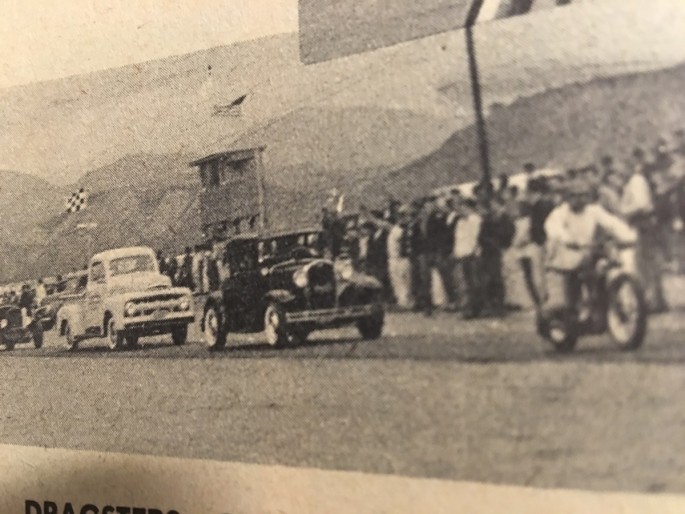
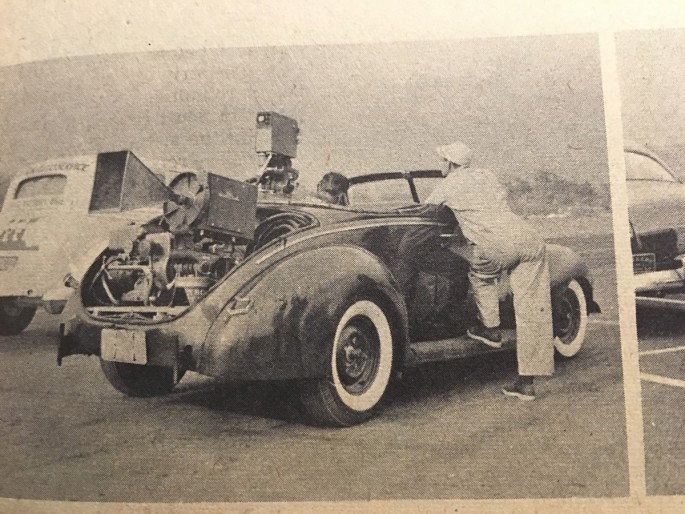


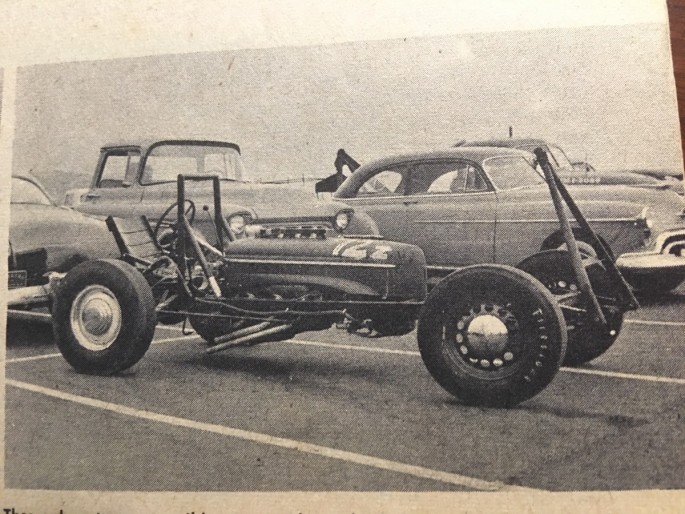
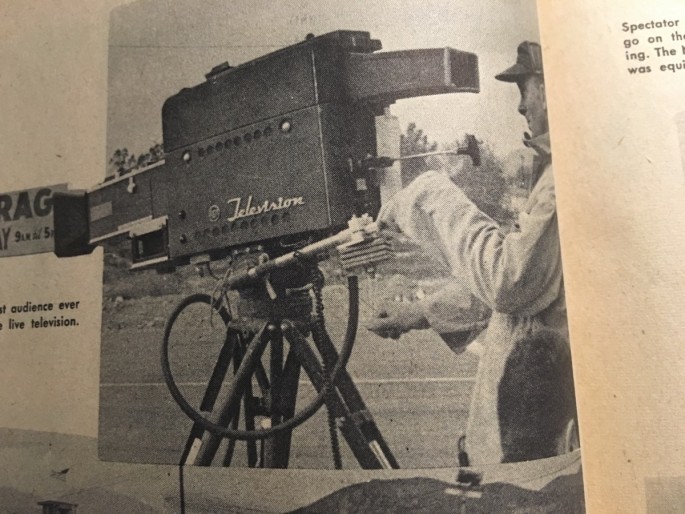
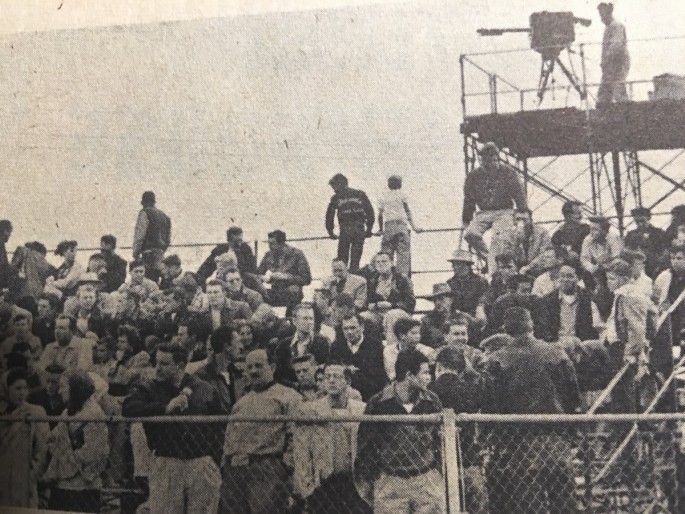





Caption for header photo – “When it hits 88mph it’ll blast me forward in time to 2016!”